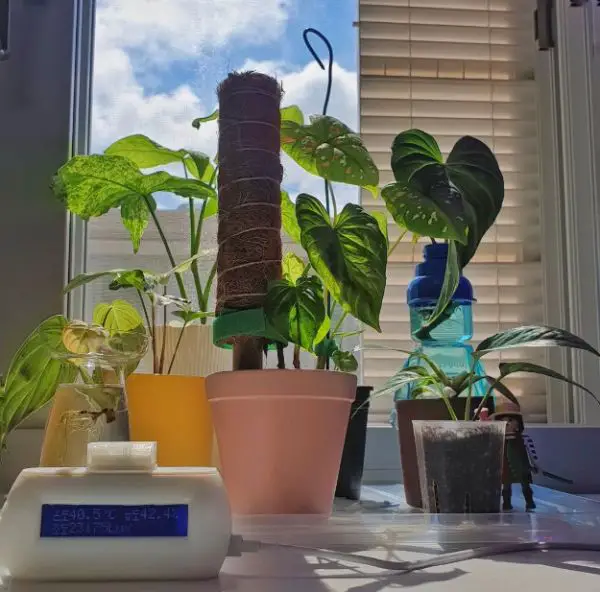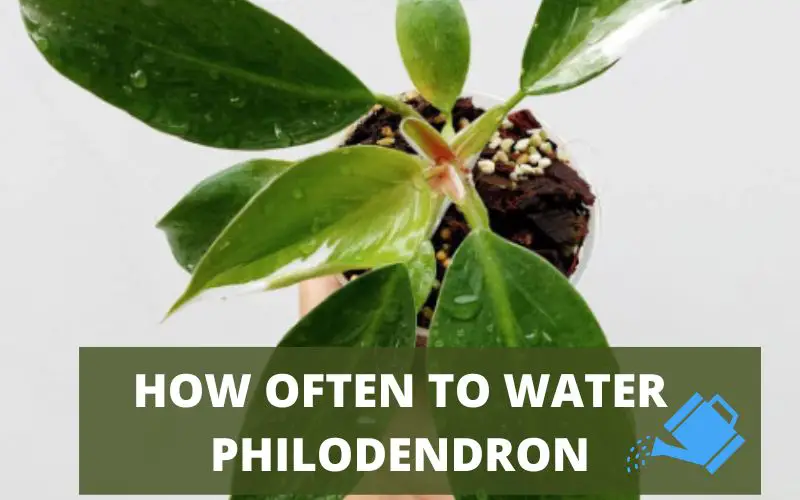Philodendron is a great plant for beginner grow plants. They don’t require a lot of care or attention and they’re very forgiving if you forget to water them. Y
Different types of Philodendrons need different levels of water, and the amount of water your plant needs also depends on factors such as the temperature, humidity, and size of the pot. In this blog post, we will discuss how to water your Philodendron correctly and provide tips for keeping your plant healthy.
How Do You Know If Your Philodendron Needs Watering?
Philodendrons are tough plants and can withstand a fair amount of neglect. However, they will not thrive if they are constantly left to dry out.
The way to tell if your Philodendron needhttps://extension.umd.edu/resource/watering-indoor-plants#:~:text=A%20common%20question%20is%2C%20%E2%80%9CHow,watered%20when%20they%20need%20it.s watering is:
- Stick your finger into the soil. If the soil feels dry 2-4 inches below the surface, let to water.
- The color of the potting mix often gets lighter as it dries. So keep an eye on it.
- Use a moisture meter to the moisture level in your Philodendron’s potting mix.
- Be sure to give your plant a good soaking, until water runs out of the drainage holes at the bottom of the pot. Allow the soil to dry out again before watering again.
If you see your plant leaves drooping, this is a sure sign that it needs water. Also, symptoms like:
- Drooping leaves.
- Brown spots on leaves
- Leaves dry.
- Wrinkled leaves.
- Leaves are turning yellow, brown, and black.
Generally speaking, most Philodendrons need to be watered every one to two weeks.
How often to water Philodendron?
Philodendrons are plants that grow in the tropical rainforest, where they endure high levels of humidity and heavy rainfall.
However, this does not imply that Philodendrons prefer wet weather, as this might result in root rot. The surplus water needs to be able to drain from the soil.
The best technique to water the Philodendron is to simulate its natural environment. Make sure to water it well enough for the drainage holes to begin to fill with water and for the roots to receive water.
Before watering the plant, make sure the top two layers of soil are completely dry. To make sure the Philodendron receives proper humidity, water it once or twice a week.
When you should water your Philodendron next can be determined by the moisture content of the soil. You should check the potting mix’s moisture content
While drooping leaves, can also be a symptom of overwatering, thus this is not the most accurate technique to determine whether to water or not.
Lighting, interior temperature, and humidity levels all affect how often to water plants. You’ll need to water less frequently when it’s dark, cold, and humid outside. You’ll need to water more frequently when the temperature is higher, there is lots of sunshine, and the humidity is low.
As a result, you must water your Philodendron while taking these factors into consideration. You shouldn’t follow a schedule that is frequency-based Philodendrons tolerate low watering far better than they do excessive irrigation.

Amount of Watering for Philodendrons
Watering frequency for Philodendrons is determined by many factors. Some of these include the type of potting mix used, plant size, temperature, humidity, seasons, and the type of Philodendron.
Potting mixes
Philodendrons want a rich potting medium that is kept moist and well-draining, never soggy
The potting mix will keep more water and take longer to dry if it retains too much water. This could cause your plant to experience severe issues, such as root rot.
Make sure your Philodendron’s pot can drain because it is much simpler to prevent these issues than to fix them.
Never add stones or ceramic shards to the bottom of your pots, to do so to improve drainage.
Typically, this has the reverse effect and might result in water accumulating in the pot’s bottom, raising the danger of root rot.
Rich soil mixtures are not recommended for Philodendrons since they can suffocate the roots because they retain too much water.
Humidity
For these Philodendron plants, a humidity level between 50% and 70% is excellent.
Your Philodendron will need a bit less watering if it receives adequate humidity. To keep the right humidity levels, you can spritz your Philodendron or use a humidifier.
Philodendrons come from humid jungle regions, thus low humidity will cause your plant to dry up.
When the lower the humidity, the quicker water evaporates from your plant’s leaves and is drawn out into the dry air.
If low humidity causes dehydration, it can happen extremely rapidly and could kill your plant.
You may also like: Do Philodendrons like humidity?
Temperature
All philodendron kinds appreciate temperatures no lower than 75 to 85 degrees Fahrenheit (24 and 30 degrees Celsius) during the day and 65 and 70 degrees Fahrenheit (18 and 21 degrees Celsius) at night.
Your Philodendron plant requires a lot more water when the temperature is high; conversely, when the temperature is low, the Philodendron’s water needs also become low.
In warm weather, your plant uses the water to sustain good cell activity and swiftly develops. In order to prevent the plant from experiencing issues, you need to maintain the right temperature levels.

Seasons
Spring and summer
There are the Philodendrons’ growing seasons. The light is at its strongest during this time, assisting plants that promote growth.
During this time, the Philodendron needs more indirect light, and more water. The amount of light causes the soil to dry very quickly, which causes the Philodendrons to soon become thirsty.
How often to water Philodendron? Yes, you should routinely water your Philodendron throughout this period.
Make sure the soil is at least 70–82% dry before watering the plant. You can continue with weekly watering of the Philodendron. But before watering, you should still inspect the soil.
The Philodendron prefers high humidity levels, however, the soil may quickly dry up and require more water if humidity levels are low and temperatures are high.
Winter
During the winter months, when growth slows down significantly, your Philodendron will need much less water.
Because the temperature is lower, drying of the soil takes longer. The rate at which water evaporation from the pot occurs will be slower when warmer temperatures.
As a result, you should water less frequently in the winter, perhaps once every 10 days or twice a week, and only water when it’s required.
It may require watering every couple of weeks or every couple of months, depending on its size and location.
Our homes’ central heating systems cause the humidity levels to be lower in the winter than they are in the summer.
Even though your Philodendron needs less water in the winter, it still requires at least 40% humidity to prevent drying out.
To avoid overwatering, you should always check the soil before watering, even in the winter.
Only use water that is room temperature to water the plant, don’t water it with cold water.
The type of Philodendron and plant size
Some Philodendrons, such as the heartleaf Philodendron (Philodendron Hederaceum), are more drought-tolerant than others and can withstand longer periods of dryness.
Conversely, other Philodendrons, such as the tree Philodendron (Philodendron Bipinnatifidum), are more sensitive to drought and will need to be watered more frequently.
If your Philodendron is small to medium-sized, kept in a container no more than six inches, with well-draining potting soil, and kept at the recommended temperature range.
You’ll probably need to water your plant once or twice a week in the summer and about once per month in the winter.
In the same conditions, you should water a huge plant in a large container slightly less frequently—once a week in the summer and just seldom in the winter.
You should get to know your plant because this is just a guide, so keep that in mind!
Pot
How frequently you need to water your Philodendron can also depend on the type of pot you’re using. For instance, a clay pot will dry out more quickly than a plastic pot.
How frequently you need to water your plant can also depend on the size of the pot. Compared to a large pot, a tiny pot will dry up more quickly.
Philodendron watering: How and how much?
- You should water your plant from below, soaking the pot in water for 35 to 55 minutes, then taking it out. This prevents the leaves from being exposed to excessive moisture, which could cause them to decay, and lets the roots absorb the water they require.
- If you must frequently water your Philodendron plant from above, avoid getting water on the plant’s leaves or stem.
- Remember to use a lot of water—enough that it overflows the pot’s bottom. The water can drain so that it may reach the plant’s lowest roots and clear out mineral buildup in the potting mix. This will prevent the pot from being submerged.
- Use a tray or saucer to hold the water if you keep your plant on it Make sure the plant gets a full, deep drink; you might need to fill the saucer, or a tray many times. Remove any remaining water around an hour later.
- Many different kinds of plants benefit greatly from the use of self-watering pots. When your plant needs water, these containers include a special bottom reservoir that collects it and gently distributes it into the potting mix.
- As a result, you won’t need to water your plant as regularly. The design of self-watering pots also aids in reducing the risk of root rot since water drains into the reservoir at the bottom of the pot rather than remaining in the soil.
How to water Philodendron
Philodendron water requirements
Philodendron plants are a common fixture in many homes, thanks to their heart-shaped leaves and easy-going nature
Yet certain varieties, like the Philodendron Pink Princess, are only mildly susceptible to chlorine and other common contaminants in tap water.
For instance, leaf stress can occur at chlorine concentrations of 400 mg/L or more.
By allowing the water to stand for half a day, chlorine may be naturally removed from tap water through evaporation.
You can also use carbon filters to eliminate chlorine for a speedy removal process and to lessen the work required to store extra water.
Conclusions
Your plant will require additional watering if you reside in an area that is usually hot or dry. Your plant will require less regular watering if you reside in a cooler or more humid region.
So, how often to water Philodendron? The answer is this depends on the type of Philodendron, the size of the pot, the type of soil, and how much light it is getting. The main points to remember are as follows:
- The amount of light a Philodendron receives will affect how often you need to water it.
- The size of the pot and the type of soil used also play a role in how much water your Philodendron needs.
- Verify the weight of the pot to determine whether your plant needs watering.
If you’re looking for a general rule of thumb, try watering your Philodendron every other week or when the pot feels heavy. let’s post questions in the section below!


